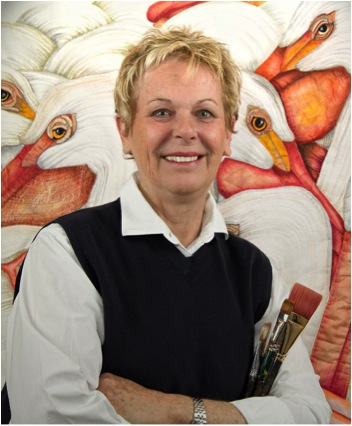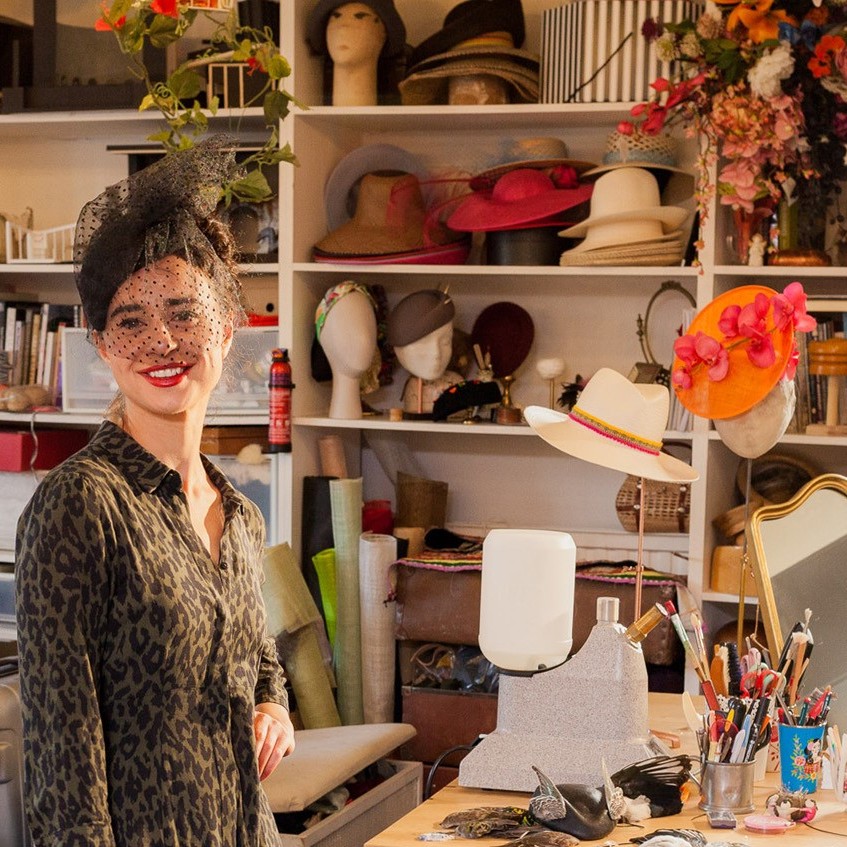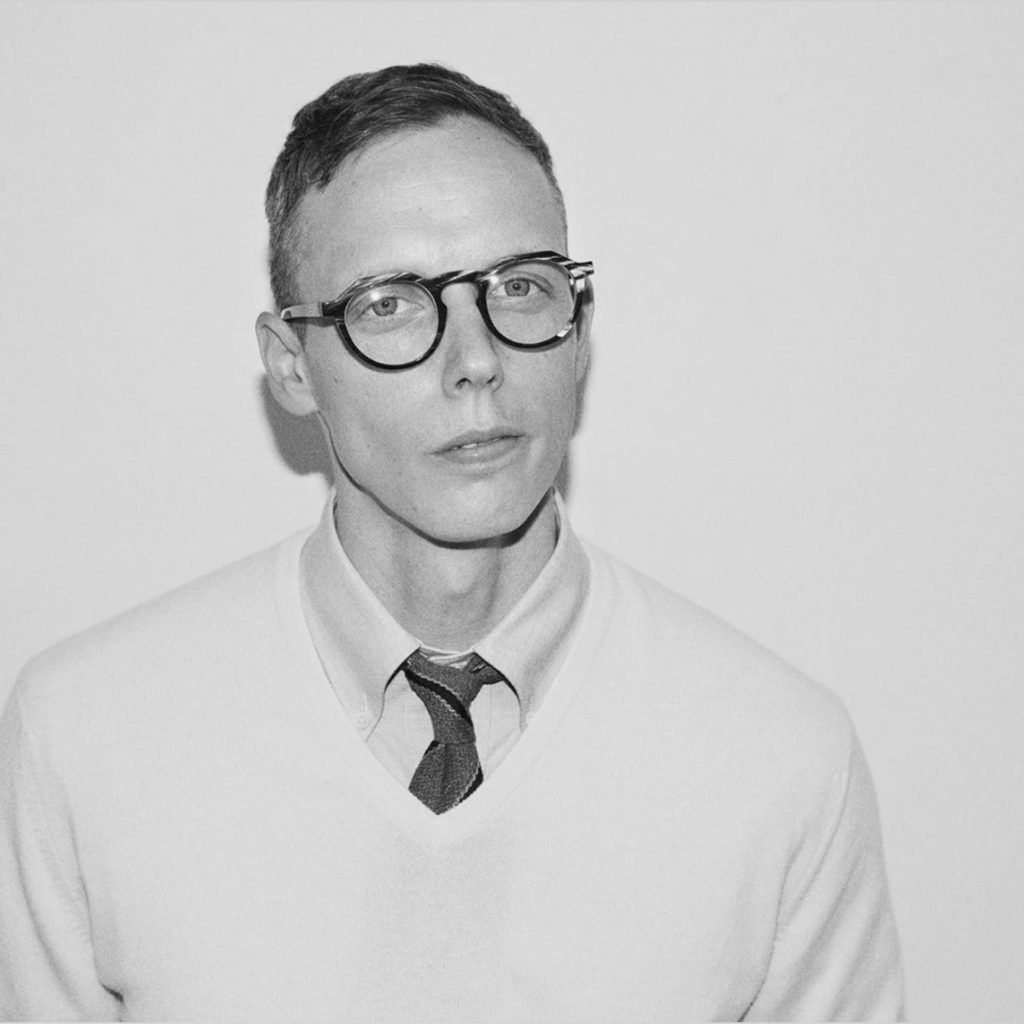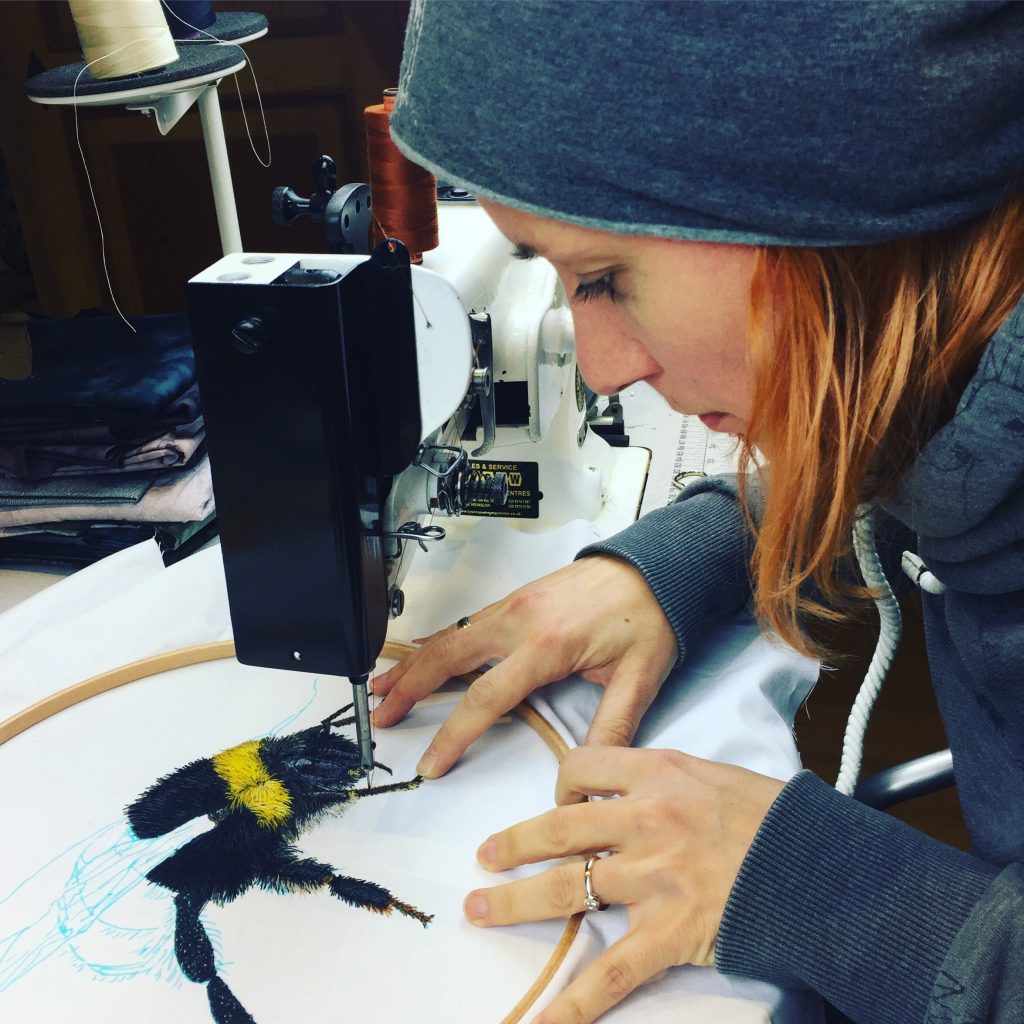Velda Newman Textile Artist - California, USA
You began your artistic life as a painter: explain how this helps you now with your quilts?
I think the most important thing about being an artist is that it gives you confidence in yourself and your decisions towards your art. Having taking many classes on the principals of design, colour and composition, I took those skills and applied them to fibre. In art classes, you are always encouraged to experiment, so using paint, ink, resist and bleach etc, when making quilts these aspects all seemed the natural thing to do.
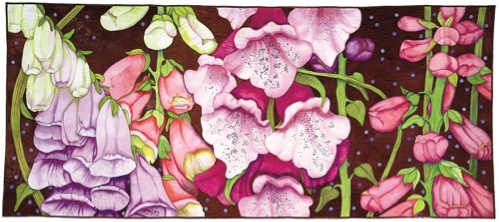
‘Foxgloves’
Can you explain the technique you use to make your quilts?
First, I’m looking for inspiration for the project. What interests me most is something from the natural world, beautiful fruit, birds, and of course my favourite subject, flowers. I want to be excited by the colour choices, possible shapes and interesting texture choices which could go into the process of creating the piece. As I start the composition, colour is always one of the first considerations. Few things elicit a more immediate or stirring response. Colour can sell a product, elevate a mood and evoke emotion. It’s reassuring to know that with all its power, effective use of colour does not require a degree in colour theory. Great colour combinations are all around us and nature is our greatest teacher.
After colour, I focus on shape. Shapes are the building blocks of design. Each shape is broken down and simplified, and made into a working pattern. In my quilts the challenge lies in giving a flat piece of fabric three dimensional characteristics.
By determining how the shapes relate to one another in scale, colour, perspective and balance, you can achieve a convincing composition.
Once the drawing is complete, I use an overhead projector to scale up to a full size drawing. This is what I call a “master pattern”. Individual patterns are made using the “master pattern” as a guide.
Next, fabric is dyed. I usually dye a range of colours. For instance, if I am using a medium pink, I will dye one yard pieces ranging from pale pink to deep fuchsia. I like to have five or six colour choices to pick from. Sometimes I make appliquéd quilts (shapes stitched to a background) but more and more I am making “collage” quilts, each shape is stitched to another shape, and there is no “background fabric”. For the ZINNIA quilt, each flower is composed of many petals, each is cut out of fabric, assembled into the flower shape and stitched together. All edges are basted to the back side. When all flower shapes are completed in this manner, they are pinned to the design wall to check the final composition as drawn. Any adjustments can be made at this time. These shapes are then stitched together. Once the top is complete, I add in decorative stitching and any ink work that I want to add.
From here, the work is backed and stitched together.
Size – this must be discussed early: how do you both produce work on this large scale and how do you enlarge such small natural objects without them losing their beauty?
Producing large scale work is always challenging, plus it takes a large commitment of time. Any mistake is magnified big time. It’s hard work and takes lots of muscle power to move all of the fabric around. You need a LARGE table and wall to work on. Sometimes I use the classroom at the local quilt shop. Most of all, you need persistence, dedication, and a vision. By enlarging small natural objects, you have the opportunity to add lots of detail with colour and texture. This adds interest and provides a look into the natural object that would otherwise go unnoticed. The centre of a flower or the mottled colours on the seashell are good examples.
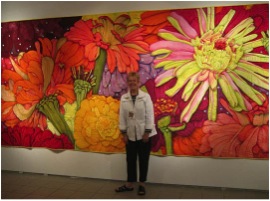
You do an extensive amount of teaching, how important is this aspect of your working year?
I love to teach. The interaction with the students is wonderful, they always bring ideas to the party! Teaching cuts into your studio time, but I think it’s time well spent.
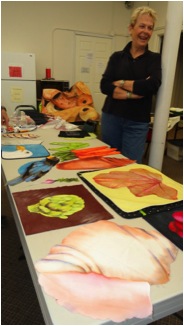
Velda in the classroom
Exhibitions: how do you decide when and where to exhibit?
The first question I always ask, does the venue have LARGE, WHITE walls! That’s the most critical objective to show my quilts to their best advantage. Right now, I have a solo exhibit at the Shelburne Museum in Vermont (USA). They had room for all of the really large pieces without crowding, white walls and the show runs for six months. May – October, 2013.
Cropping is a very important part to your design. Can you expand on this?
Instead of a straight-on “picture frame” perspective with borders, I employ the concept known as “point of view”. An eye level view puts you face to face with the subject. This invites the viewer into the design. To some extent, I do this through scale, if the shapes are large, you naturally feel close to them.

‘Geranium’
When did you find your own style and how did you know that you were ready to make this move?
I had always been aware of quilts, but never had made one, when I read about a quilt contest. I thought it might be interesting to enter. I drew up a simple design, made a quilt out of it and entered the contest. It won a “Judges Choice Award” given by Jean Ray Laury and $50.00. This was my first time to view a quilt exhibit. When I walked in and saw the “sea of quilts”, I knew I had to do something to make my quilts stand out from the rest. That’s when I started making large scale quilts. My second quilt won Best of Show @ Houston, TX and I have never looked back.
Working with textiles: how do you deal with the colours you need?
That the easy part. I hand dye all of my fabric and love doing it! I also use paint, ink, pencils, resist and colour remover. Anything to get the look that I’m after.
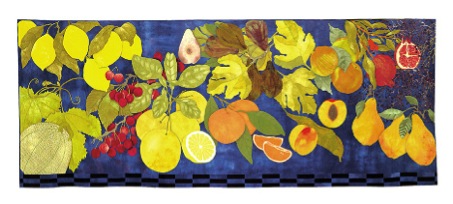
‘Sunkissed’
What have been some of the obstacles you have had to cope with in your textile career?
I think “time” is the biggest factor, never enough time! Large pieces can take one or two years to complete. And I would love to have a dedicated “dye” studio connected to my stitching studio.
Can you discuss 3 quilts?
AMERICAN WHITE PELICAN.
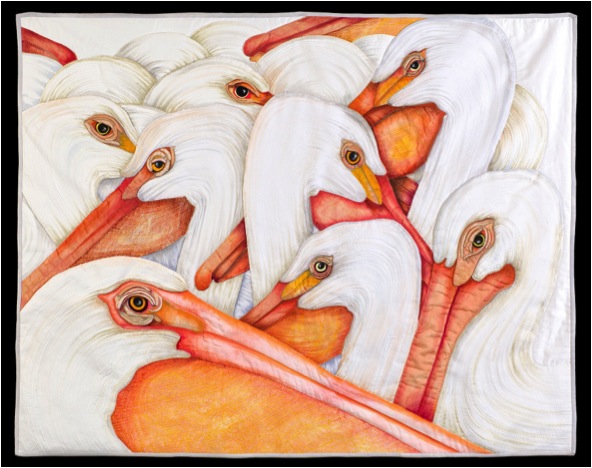
While on vacation at the beach in California, I had an opportunity to photograph these wonderful birds.
They look almost prehistoric and even comical to some degree. The technique is “collage” style and measures three feet by four feet. The majority of the texture stitching has been done on the machine. Paint and ink were used. Cotton sateen and cheese cloth are used. Hand quilted.
ZINNIA
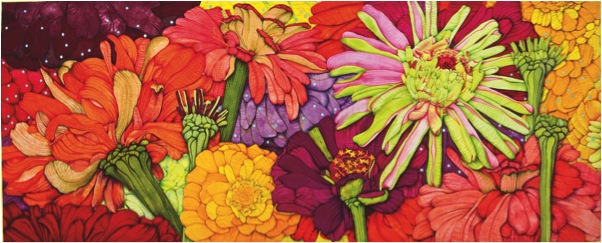
This is a quilt made in the “collage” style. It is eight feet by eighteen feet wide. This piece took two years to complete. It is hand stitched and hand quilted. The inspiration for this piece came from Zinnia’s growing in my backyard. I photographed them when they started blooming and continued until they were done. The turquoise dots represent floating pollen. Paint and ink were used. Fabric is cotton sateen.
HYDRANGEA
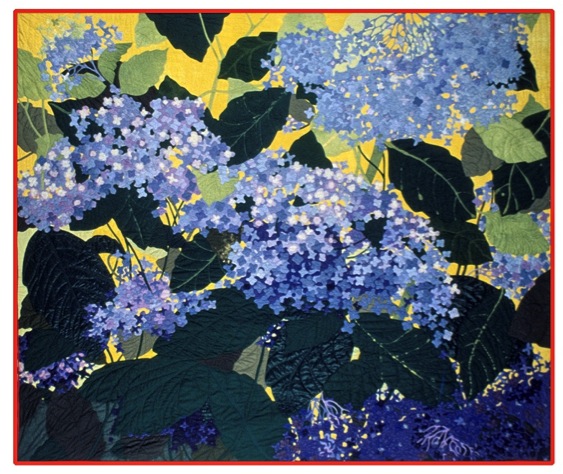
This is an Applique quilt, seven by eight feet. Hand stitched and hand quilted. This quilt presented several problems; first, hand dying enough different blues to get the depth needed to separate the blossoms. Second, capturing the delicate look of the blooms and thirdly, finishing this quilt in my lifetime. Each blossom was cut like a four leaf clover and is the size of a silver dollar. The HYDRANGEA quilt is in the collection of John M. Walsh, it was an honour to have this piece chosen as one of the top 100 quilts for the 20th Century.
Your studio, everyone loves to know about an artist studio. Can you tell us about yours?
My studio is small and compact. The one thing I cannot do without is my twenty foot design wall. I don’t need a lot of fabric storage space. I have a few bolts of “prepared for dye” fabric, a place for my computer, an ironing board and a 36″ X 72″ table.
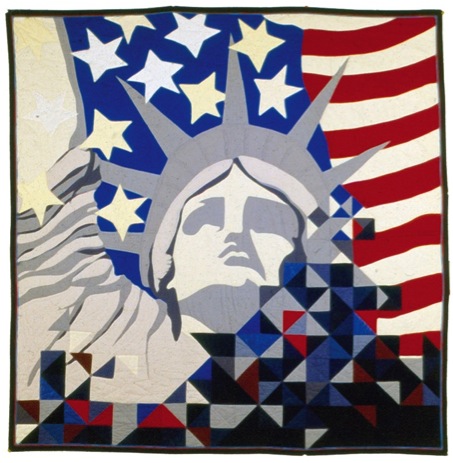
‘Freedom is Fragile’
Explain one of two tips you would give to new artists?
I think the most important thing is to find your own path and follow it!
Look at all kinds of art. I love to go to museums whenever I travel.
Try new things, there is lots out there to explore and experiment with.
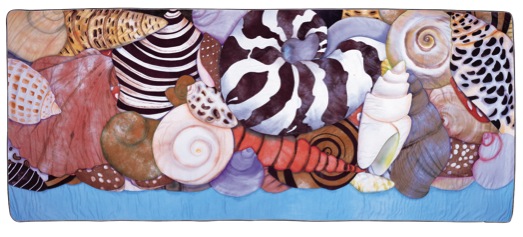
‘Shells’’
Contact details.
Email: veldanewman@mac.com
Web: www.veldanewman.com
Velda Newman, California, USA
Interview by Deborah Blakeley, August, 2013
Think a colleague or friend could benefit from this interview?
Knowledge is one of the biggest assets in any business. So why not forward this on to your friends and colleagues so they too can start taking advantage of the insightful information the artist has given?
Other artists you may be interested in:


